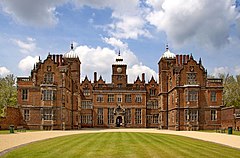Aston Hall
| Aston Hall | |
|---|---|
 |
|
| General information | |
| Type | Mansion |
| Architectural style | Jacobean |
| Location | Aston, Birmingham, England |
| Coordinates | 52°30′23″N 1°53′3″W / 52.50639°N 1.88417°WCoordinates: 52°30′23″N 1°53′3″W / 52.50639°N 1.88417°W |
| Construction started | April 1618 |
| Completed | April 1635 |
| Design and construction | |
| Architect | John Thorpe |
| Awards and prizes | Grade I listed |
Aston Hall is a Grade I listed Jacobean house in Aston, Birmingham, England, designed by John Thorpe and built between 1618 and 1635. It is a leading example of the Jacobean prodigy house.
In 1864 the house was bought by Birmingham Corporation, becoming the first historic country house to pass into municipal ownership, and is still owned by Birmingham City Council. It is now a community museum managed by the Birmingham Museums Trust and is open to the public during the summer months, after a major renovation completed in 2009.
Designed by John Thorpe, construction commenced in April 1618 by Sir Thomas Holte, who finally moved into the hall in 1631. It was completed in April 1635. It is Grade I listed.
The house was severely damaged after an attack by Parliamentary troops in 1643; some of the damage is still evident. There is a hole in the staircase where a cannonball went through a window, an open door and into the banister. The house was built by Sir Thomas Holte and remained in the family until 1817 when it was sold and leased by James Watt Jr., son of industrial pioneer James Watt. The house was then purchased in 1858 by a private company (the Aston Hall and Park Company Ltd) for use as a public park and museum. After financial difficulties it was then bought by the Birmingham Corporation in 1864 becoming the first historic country house to pass into municipal ownership.
It was also visited by Washington Irving, who wrote about it as Bracebridge Hall, taking the name from Abraham Bracebridge, husband of the last member of the Holte family to live there. Irving's The Sketch Book stories depicted harmonious warm-hearted English Christmas festivities he experienced while staying in Aston Hall, that had largely been abandoned. An Aston Hall Christmas Eve custom the owners afforded the servants of the house appeared in The Gentleman's Magazine in 1795, which wrote, "the servants have full liberty to drink, dance, sing, and go to bed when they please."
...
Wikipedia
